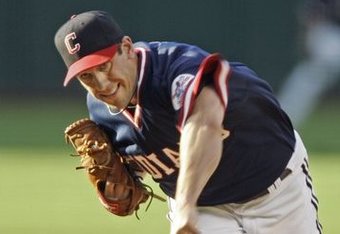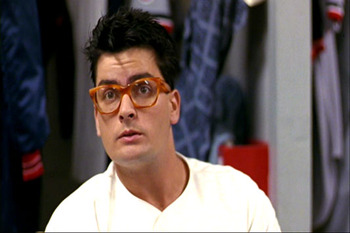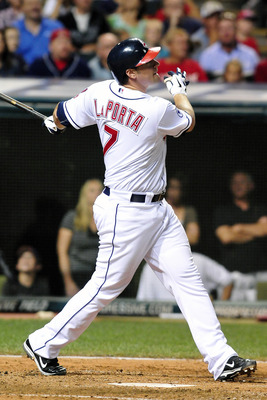 After a rough start at home, and an opportunity to gain their footing with their first road series against a not-ready-for-primetime Kansas City Royals team, the Cleveland Indians are officially playing .500 baseball for the first time this season. However, plenty of questions remain; above all else, I am left to ask if this 2012 team is any good.
After a rough start at home, and an opportunity to gain their footing with their first road series against a not-ready-for-primetime Kansas City Royals team, the Cleveland Indians are officially playing .500 baseball for the first time this season. However, plenty of questions remain; above all else, I am left to ask if this 2012 team is any good.
Sadly, until proven otherwise, the offensive onslaught in Kansas City has to be categorized as a fluke for the time being. I’m not saying that the Indians need to get to their 2011 benchmark of being 30-15 by mid-May, but I need some evidence that this lineup can produce a timely hit, or that the bullpen may function consistently in close ball games. So far, success seems to be more the exception than the rule in those areas.
Even with the futility of that season opening home stand behind them, the team is still hitting .238 collectively and the bullpen regulars (not counting Josh Tomlin and Jeanmar Gomez relief cameos) have put together an ERA well over 6. It’s hard to look at that on paper, and I do realize we only have 8 games under our belts, and open our mind to the possibility that this is a bad baseball team.
Scarier yet is the search for the light at the end of the tunnel, and a noticeable void in the results of that search, which might have some thinking that this is more than a bad team; we could be watching a bad organization here. Looking down to the farm system, there are a few, a very few, bullpen arms that might be able to help out this season, but are we really holding our breath for Chen-Chang Lee and Nick Hagadone to right the ship? Also, that offensive pop is still a few years out, unless players of the Cord Phelps or Thomas Neal ilk really step up soon.
 Of course, there is the chance of a reclamation project, a little time in the minors to work things out; the route Lou Brown was ready to go down with Rick Vaughn before discovering he was blind as a bat. By calling up Aaron Laffey to replace him in the rotation, the Indians brass achieved some success by sending Cliff Lee to the bus leagues for 48 innings in 2007. Lee bounced back to go 22-3 during his 2008 Cy Young Award winning season, and has been a bona fide ace in the three uniforms he’s worn since departing via trade in 2009. Similar results were seen from Roberto “Fausto Carmona” Hernandez after 40-some Minor League innings in 2009, however that undoing of bad was only temporary, and the big league club got 7 wins and 15 losses out of their Opening Day starter in 2011.
Of course, there is the chance of a reclamation project, a little time in the minors to work things out; the route Lou Brown was ready to go down with Rick Vaughn before discovering he was blind as a bat. By calling up Aaron Laffey to replace him in the rotation, the Indians brass achieved some success by sending Cliff Lee to the bus leagues for 48 innings in 2007. Lee bounced back to go 22-3 during his 2008 Cy Young Award winning season, and has been a bona fide ace in the three uniforms he’s worn since departing via trade in 2009. Similar results were seen from Roberto “Fausto Carmona” Hernandez after 40-some Minor League innings in 2009, however that undoing of bad was only temporary, and the big league club got 7 wins and 15 losses out of their Opening Day starter in 2011.
With Hernandez, his pitching has proven to be as inconsistent as his forms of legal identification, having never equaled his stellar 19-8 performance of 2007, often going in the other direction with overwhelmingly poor performance in the years since. That’s the shame of looking back on the 2007 Indians that came “oh-so-close”. What if Cliff Lee could have put it together in that year where CC Sabathia was the Cy Young winner, and Fausto was worthy of his 4th place finish in the voting, right? Unfortunately, when Lee stepped his game up, Carmona and Sabathia took big enough steps backwards that Sabathia was moved to Milwaukee almost month before the 2008 trade deadline.
The Brewers sent Rob Bryson, Zach Jackson, Matt LaPorta, and a player to be named later back to Cleveland in the deal. Later, they named that player Michael Brantley. Hindsight reveals that the Indians were perhaps “fleeced” on this transaction, and while CC lived up to his “rent-an-ace” status in the National League Central Division, not one piece of the return package has lived up to its billing, even without any expectations of receiving 100 cents on the dollar for the 11-2 record Sabathia posted with the Brewers while carrying them to the postseason.
There’s still hope for Bryson, who is 24 years old and pitching well in AA, but Zach Jackson is out of baseball after eating 63+ innings for the 2008 & 2009 Tribe with a 6.11 ERA. There was more to that blockbuster deal than just pitching; the can’t miss outfield prospect Matt LaPorta was the highlight of the trade. He was hitting .288 with 20 bombs for AA Huntsville at the time of the trade, and after a brief struggle to adjust with the organization in 2008, LaPorta  continued to progress through the minor leagues with solid numbers.
continued to progress through the minor leagues with solid numbers.
Brantley, who also had some nice numbers in Huntsville, was chosen over Taylor Greene. Though, Brantley has not exactly lived up to expectations as Cleveland’s lead-off hitter, his Major League service time considerably dwarfs Greene’s 37 plate appearances with the Brewers. While the Indians chose Brantley, it has been widely speculated that they settled for Matt LaPorta while desiring Mat Gamel’s services. Looking at Gamel’s .227 batting average at the big league level, it appears that even hindsight couldn’t make that trade look better in the present tense, not with the Brewers anyways.
So, the Indians continue to market the whole “What If” slogan, and I’m prepared to take that approach as a spectator. The Indians need a right-handed bat, they need some pop in the lineup, and the front office needs something good to come from that Sabathia deal in order to save some face on that one. So, here it is; what if Matt LaPorta can work out his issues with the minor league club? What if the “Cliff Lee Plan” is the answer for the former Future Star?
Is this flawed logic? It absolutely is, but no more so than the Oklahoma City Plan, that basketball fans in Northeast Ohio pray their NBA team follows. To keep it baseball, we can refer to it as the “Tampa Bay Rays” plan, but the theme is the same; be patient with the bad things for a prolonged period of time, then wait for the pay off in the end. In both cases, those present day contenders had to put their fan bases through a lot of suffering, but they were rewarded for it in the end. Perhaps Cliff Lee’s 5-8 record and subsequent demotion in 2007 doesn’t at all feel like the underachievement of one Matthew Vincent LaPorta, but that might be because the book on LaPorta may not yet be complete.
 Look, over the last few years we’ve learned that some wonderful minor league ballplayers suffer that Crash Davis syndrome, where they set records in the bus leagues, but the white baseballs used for batting practice in the show just prove to be too much glitz for these guys. We have come to know these guys as Quadruple-A guys, players who excel at the highest Minor League level, but look lost against the cream of the crop. If there were a AAAA Hall of Fame, former Indian Luis Valbuena could be a charter member. The fear is that LaPorta and his .298 Minor League batting average (.312 in AAA) belongs in that group.
Look, over the last few years we’ve learned that some wonderful minor league ballplayers suffer that Crash Davis syndrome, where they set records in the bus leagues, but the white baseballs used for batting practice in the show just prove to be too much glitz for these guys. We have come to know these guys as Quadruple-A guys, players who excel at the highest Minor League level, but look lost against the cream of the crop. If there were a AAAA Hall of Fame, former Indian Luis Valbuena could be a charter member. The fear is that LaPorta and his .298 Minor League batting average (.312 in AAA) belongs in that group.
I don’t know if I agree with that. Sure, LaPorta isn’t performing at the plate, doesn’t appear he can field his position, and I would guess he’d be an Honors Student at the Manny Ramirez Baserunning Academy, but I am not prepared to throw in the towel. I believe that time can heal the wounds of inept hitting against great pitching, provided a player has an open mind to being coached and a track record of hitting pretty good pitching, such as the caliber that LaPorta continues to clobber down in Columbus.
The bottom line is that you can put the other things on the back burner with LaPorta, because none of it matters if he cannot hit Major League pitching. His numbers are poor with Cleveland, but beyond the box score, LaPorta is featured in some of the most miserable at-bats I’ve seen in almost thirty years of watching this game. If he hits the first pitch he sees, he’s fine, but when he gets down in the count, his approach is always one of panic, and that’s what makes him such a miserable two strike hitter.
The near-trade for Bobby Abreu at the end of Spring Training meant bringing a wonderful two-strike hitter into the fold. I saw this as a wonderful opportunity for LaPorta to learn, but alas, the trade for the Angels outfielder never got off the ground, but LaPorta might still be in some good hands. AAA Hitting Coach Phil Clark has demonstrated his ability to develop players offensively with other Tribe affiliates, and with all apologies due to Bruce Fields, Columbus Manager Mike Sarbaugh might be the best offensive mind the Indians organization has had since Charlie Manuel was dismissed.
Now, I don’t expect LaPorta to put the ball in play with the efficiency of an Asdrubal Cabrera, but at the age of 27, I can’t rule out the possibility that LaPorta can put it together with a few months in AAA. His biggest problem is that he swings at bad pitches, and let’s a few meatballs fly by for called strikes. That’s why his power numbers suffer. When he starts swinging at the right pitches, a philosophy that Shin-Soo Choo preaches, the .285 batting average and 20-25 home runs will follow.
Of course, all of this is only a “best case scenario” type of outlook. Sometimes a .230 hitter is just a .230 hitter, and some guys are just built to tear up the bus leagues. While the injury gods haven’t been kinds to Rob Bryson, and while the game of baseball gave up on Zach Jackson, I’m not holding out hope for Michael Brantley to be anything special either. But, for the sake of all things CC Sabathia related, how nice would it be for that silly “Cliff Lee Plan” to work for Matt LaPorta, of all people?
What if?